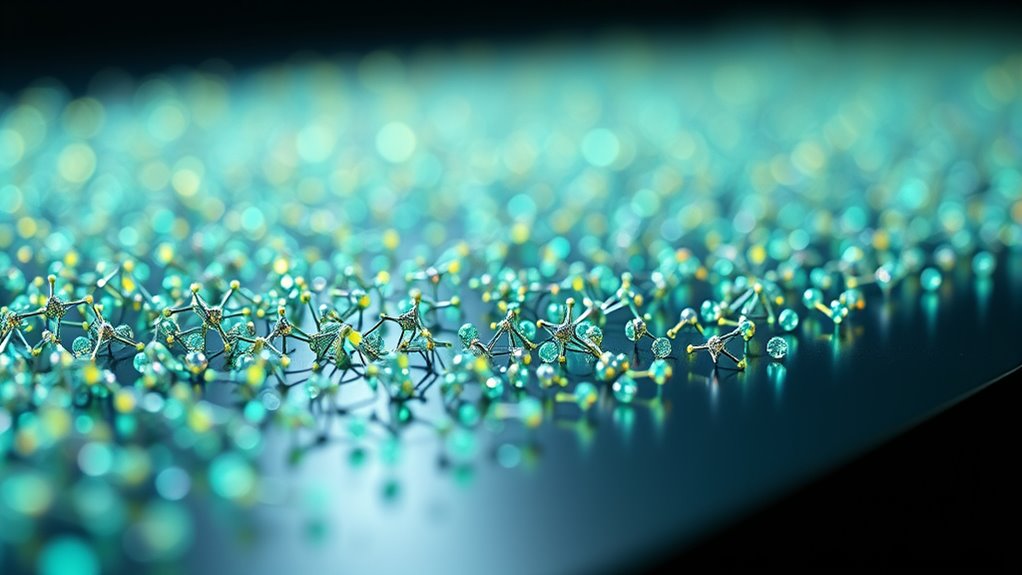Energy-efficient nanomaterials are designed at the nanoscale to maximize energy capture, conversion, and storage in renewable technologies. They’re made using sustainable methods like chemical vapor deposition and sol-gel processes, which reduce waste and energy use. These materials are lightweight, flexible, and highly customizable, helping to improve device performance and durability. By exploring innovative nanomaterial synthesis, you can discover how future energy challenges are being addressed with smarter, more efficient solutions.
Key Takeaways
- Nanomaterials enable precise control over properties to enhance energy capture, conversion, and storage efficiency.
- Scalable synthesis methods reduce waste and energy consumption, promoting sustainable production of energy-efficient nanomaterials.
- Tailored nanostructures improve charge transport and reduce energy losses in renewable energy devices.
- Lightweight, flexible nanomaterials expand applications while maintaining high performance and energy efficiency.
- Advanced nanomaterials serve as catalysts and functional components to increase the sustainability of energy technologies.

Advancements in nanomaterials are transforming the way we approach energy efficiency. These tiny materials, often just a few nanometers in size, hold incredible promise for revolutionizing how we generate, store, and conserve energy. Central to this progress is nanomaterial synthesis, a process that allows scientists to create materials with highly specific properties tailored for various renewable energy applications. By carefully controlling factors like particle size, shape, and surface chemistry during synthesis, you can develop nanomaterials optimized for solar cells, batteries, and other clean energy technologies. This precise control enables improvements in energy capture, conversion efficiency, and storage capacity, making renewable energy sources more viable and cost-effective.
Nanomaterial synthesis enables tailored, efficient, and sustainable solutions for renewable energy technologies.
When you focus on nanomaterial synthesis, you’re essentially designing materials at an atomic level to maximize their performance in real-world applications. For example, in solar energy, nanomaterials like quantum dots and nanostructured thin films can considerably boost light absorption and charge transport, leading to more efficient photovoltaic devices. In energy storage, nanostructured electrodes increase surface area and conductivity, resulting in batteries that charge faster and last longer. The ability to fine-tune these materials during synthesis means you can address specific challenges in renewable energy applications, such as reducing energy losses or improving durability under harsh conditions.
Moreover, nanomaterials are inherently lightweight and flexible, opening doors to innovative renewable energy solutions that were previously impractical. Imagine lightweight, flexible solar panels that can be integrated into clothing or portable devices, or nanostructured catalysts that make hydrogen production more sustainable and affordable. As you explore nanomaterial synthesis, you’ll find that the versatility of these materials allows for custom solutions tailored to specific energy needs, whether it’s for urban environments, remote locations, or large-scale power grids.
The ongoing development of synthesis methods also means you can produce nanomaterials more sustainably and at scale. Techniques like chemical vapor deposition, sol-gel processes, and ball milling are becoming more efficient, reducing waste and energy consumption during production. This aligns well with the goals of renewable energy applications, which emphasize sustainability not just in end-use but also in manufacturing processes. Ultimately, your work in nanomaterial synthesis directly contributes to making renewable energy technologies more effective, affordable, and accessible, accelerating our transition toward a cleaner, more sustainable energy future.
Frequently Asked Questions
How Do Nanomaterials Improve Energy Storage Efficiency?
Nanomaterials boost energy storage efficiency by increasing nanomaterial conductivity, which allows electrons to flow more smoothly, reducing energy loss. They also enable energy density enhancement, meaning your batteries can store more power in a smaller space. This results in faster charging, longer-lasting devices, and improved overall performance. By incorporating nanomaterials, you benefit from more efficient, compact, and reliable energy storage systems, making your devices smarter and more sustainable.
What Are the Environmental Impacts of Nanomaterial Production?
You might picture factories churning out nanomaterials, releasing tiny particles into the air and water, which can cause environmental pollution. During production, toxic waste may accumulate, threatening ecosystems and human health. These hazardous byproducts can linger, contaminating soil and water sources, making cleanup difficult. While nanomaterials hold promise, it’s essential to weigh these environmental impacts and develop safer manufacturing methods to protect our planet from long-term harm.
Can Nanomaterials Be Recycled or Reused Sustainably?
Yes, nanomaterials can be recycled and reused sustainably. You can employ recycling methods like chemical or physical separation to recover nanomaterials from waste. Sustainable reuse involves designing nanomaterials for durability and easy recovery, reducing environmental impact. By adopting these practices, you help minimize waste and conserve resources, making nanotechnology more eco-friendly. Implementing innovative recycling methods guarantees nanomaterials remain a valuable resource rather than waste.
What Safety Protocols Are Necessary for Nanomaterial Handling?
When handling nanomaterials, you need to follow strict safety protocols to protect yourself. Always wear appropriate PPE requirements, including gloves, lab coats, and eye protection, to prevent inhalation or skin contact. Use handling precautions like working in a well-ventilated area or under a fume hood. Proper disposal procedures are essential, and you should stay informed about material-specific risks to minimize exposure and guarantee safety.
How Cost-Effective Are Nanomaterials Compared to Traditional Materials?
While nanomaterials might seem like a luxury, they often prove cost-effective in the long run. You’ll find that the cost comparison favors nanomaterials due to their enhanced durability and efficiency. Although manufacturing expenses can be higher initially, the savings from reduced energy use and longer lifespan offset these costs. Over time, adopting nanomaterials can lead to significant financial benefits, making them a smart choice for sustainable development.
Conclusion
By exploring energy-efficient nanomaterials, you’re opening the door to a brighter, more sustainable future. These materials are like tiny superheroes, silently saving energy and reducing environmental impact without you even noticing. As you embrace these innovations, remember that your choices can spark a ripple effect, transforming the world into a cleaner, greener place. Just as a single spark ignites a fire, your support for nanotechnology can fuel a powerful movement toward sustainability.









